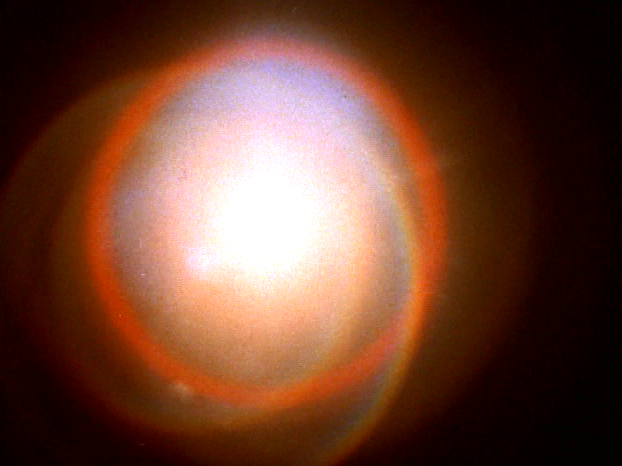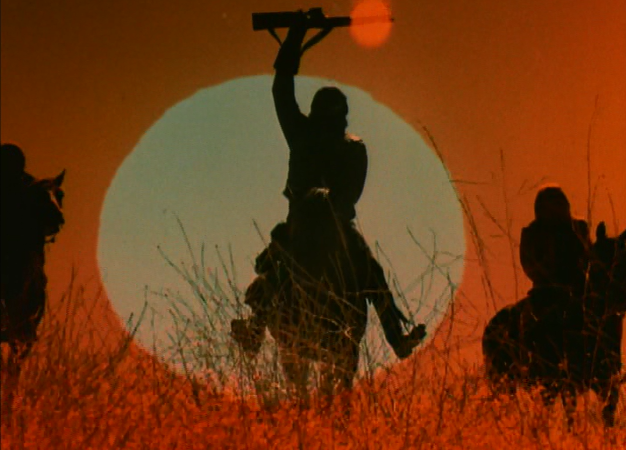The Planet of the Apes feature film franchise tackles a number of significant issues.
The films gaze at the ways that theocratic states suppress the truth (Planet [1968], Beneath [1970]) and punish truth-sayers, for instance. They also look intently at race relations (Conquest [1972], Battle [1973]).
And virtually all of the films tackle an anti-nukes, anti-war theme.
The TV series -- which ran for just one season in 1974 -- perhaps wisely chose to narrow the franchise focus some.
Planet of the Apes, the series, primarily concerns two human astronauts and their chimpanzee friend, Galen, interfacing with the Ape Society and contemplating, essentially, class or race differences.
In this universe, humans are second-class citizens with no wealth, no rights, and no equality. The apes, by contrast, control all of the society's assets. The apes believe and disseminate propaganda about humans, and consider them an inferior species.
The introductory montage dynamically sets-up the premise for the series (astronauts traveling to a future Earth ruled by apes), but more than it, it dramatically visualizes the startling gap in power between races.
In the opening montage, humans are on the run and constantly imperiled, and the Apes are un-moving avatars of force, power, and strength.
The Planet of the Apes montage commences with a view of a star in space. We get some lens flare to suggest the impact or power of the star, and then find ourselves ensconced in a spaceship control room.
On the upper-right hand side of the screen, we get two legends.
One marks Earth-time; the other ship-time.
These two numbers will begin to diverge dramatically as the spaceship experiences turbulence (a result of its proximity to the star?), and the crew experiences a time warp.
As the astronauts grow concerned at the wild turbulence their ship experiences and as ship-time and Earth-time begin to diverge, we get a new legend on-screen in red: "Abort Mission."
The extreme close-ups of the astronauts, Alan Virdon (Ron Harper) and Peter Burke (James Naughton) signal the extreme danger.
The ship's (computer...) warnings grow more plaintive in the next series of shots, as the spaceship is flung through the time warp.
Ship-time and Earth-time are continuing to diverge, but the "ABORT MISSION" red alert signal is larger in the frame. The danger is growing exponentially.
Ship-time and Earth-time are continuing to diverge, but the "ABORT MISSION" red alert signal is larger in the frame. The danger is growing exponentially.
The next several frames represent a light show of sorts, as the crew experiences the strobing, bright lights of the time warp. Once more, the time differential grows.
At the outer edge of the time warp, the time differential is now huge. It is August 1980 by the astronauts' reckoning, but May 23, 3000 by Earth time.
A ghost in space appears, shadowy and indistinct at first...
A ghost in space appears, shadowy and indistinct at first...
In the next shot, twin dangers are linked.
The star we saw at the beginning of the montage appears again, but captured in its lens flare this time s the recognizable image of an intelligent ape.
The time warp has brought these unlucky astronauts to the Age of the Ape...and accordingly, we get the series title over a view of beautiful Earth: Planet of the Apes.
The star we saw at the beginning of the montage appears again, but captured in its lens flare this time s the recognizable image of an intelligent ape.
The time warp has brought these unlucky astronauts to the Age of the Ape...and accordingly, we get the series title over a view of beautiful Earth: Planet of the Apes.
The next shot reveals the spaceship's dizzying descent into Earth's atmosphere. But Earth is a new world. It is now 3084.
To signify the "law" of that new world, we get an extreme close-up of a gorilla soldier.
He is centered in the frame and un-moving, a position and pose suggesting unyielding, constant power. From this angle, the ape is literally looking down his nose at us, as all apes look down at all humans in this world.
Next, we get a wider shot of the ape soldier. He is seated on a horse, with one arm jutting up into the air in a pose of victory. He is holding a tool of power as well: a rifle.
Once more, he does not move, but remains frozen in the frame. Behind him -- in a double-exposure effect -- the sun seems to be going down.
The orange-colored sky suggests autumn, and the sunset suggests an end to the age of man. This image means that ape is triumphant, and man is sinking...fast. The ape has eclipsed man.
Next, we meet our heroes on the run. In the first shot, Galen flees the ape regime.
The blocking is significant in the next few shots.
Three apes sit perched atop a hill (another position of dominance), while the astronauts run for their lives.
Again, the apes are perfectly still -- suggesting permanence -- while the humans are on the move, fleeing. It is no accident that the apes don't move in this intro, but the fugitives, the humans, move constantly. This is a metaphor for the power structure of Ape Society.
Next, the real power on the Planet of the Apes comes into focus. An ape rifle coalesces as, behind it, the day of humanity recedes.
The last several shots of the montage continue in the same vein. They reveal the gorilla soldier -- and his weaponry -- dominant in an orange, autumnal sky.
The Age of Man has passed. Welcome to the Planet of the Apes!
Below, the Planet of the Apes montage in living color:





































I just watched a bunch of episodes and found that I enjoyed them more than I should have. They are standard 70s drama, with stories that could translate into any environment. It just happens to be happening on a planet run by apes. It's a weird experience. I wanted more mythology. Less, human of the week drama and more time changing.
ReplyDeleteJohn, that shot of the gorilla appearing out of the darkness was the most terrifying thing I had ever seen when I was a kid of about eight. I couldn't bear to watch it, but I loved the show, so I used to leave the room until the opening credits were over. I was afraid to tell my mother how much this shot scared me, in case she stopped me watching the show.
ReplyDelete